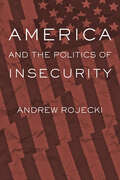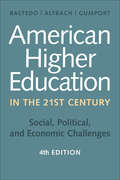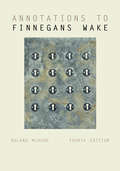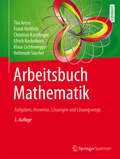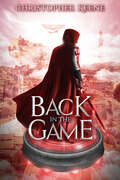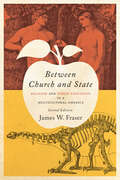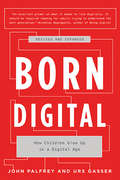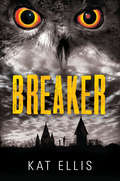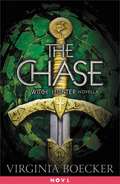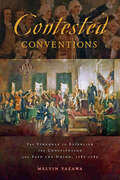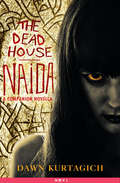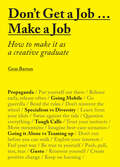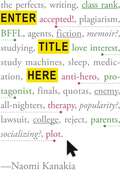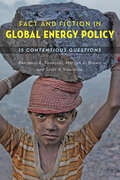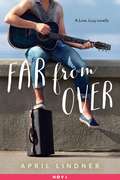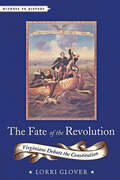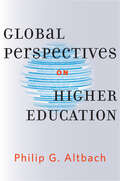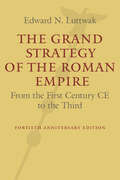- Table View
- List View
America and the Politics of Insecurity (Themes in Global Social Change)
by Andrew RojeckiIn America and the Politics of Insecurity, Andrew Rojecki assesses the response of citizens and politicians to a series of crises that confronted the United States during the first decade of the twenty-first century. This period brought Americans face to face with extraordinarily difficult problems that were compounded by their origin in seemingly uncontrollable global forces. Rojecki establishes a theoretical framework for understanding how these new uncertainties contribute to increasingly polarized political discourse. Analyzing three domains of American insecurity;¢;‚¬;€?economic, environmental, and existential;¢;‚¬;€?Rojecki examines responses to the Great Recession by groups like the Tea Party and Occupy Wall Street; considers why the growing demand for fossil fuels makes people disregard global warming; and explores the desire for security measures that restrict personal freedom in the age of terrorism. Ultimately, he explains why the right has thus far held an edge over the left in the politics of insecurity.Rojecki concludes that in order to address these broad-scale political problems, we must reframe domestic issues as reactions to undiagnosed global conditions. Bringing the psychology of uncertainty together with contemporary case studies, this book is a sweeping diagnostic for;¢;‚¬;€?and antidote to;¢;‚¬;€?ineffective political discourse in a globalized world that imports bads as well as goods.
American Higher Education in the Twenty-First Century: Social, Political, and Economic Challenges
by Michael N. Bastedo Philip G. Altbach Patricia J. GumportFirst published in 1999, American Higher Education in the Twenty-First Century offered a comprehensive introduction to the central issues facing American colleges and universities. This thoroughly revised edition brings the classic volume up to date. The contributors have rewritten every chapter to address major changes in higher education, including the rise of organized social movements, the problem of income inequality and stratification, and the growth of for-profit and distance education. Three new chapters cover information technology, community colleges, and teaching and learning.This edition seeks to capture several crucial dynamics in the nexus of higher education and society. Placing higher education within its social and political contexts, the contributors discuss finance, federal and state governance, faculty, students, curriculum, and academic leadership. They also grapple with growing concerns about the future of the academy and reflect more deeply on the racial, ethnic, and socioeconomic diversity within higher education.No other book covers such wide-ranging issues under the broader theme of higher education;€™s relationship to society. Highly acclaimed and incorporating cutting-edge research, American Higher Education in the Twenty-First Century is now more useful and engaging than ever.Contributors: Michael N. Bastedo, Philip G. Altbach, Patricia J. Gumport, Benjamin Baez, Peter Riley Bahr, Joy Blanchard, Corbin M. Campbell, Melanie E. Corrigan, Peter D. Eckel, Roger L. Geiger, Lawrence E. Gladieux, Sara Goldrick-Rab, Jillian Leigh Gross, D. Bruce Johnstone, Adrianna Kezar, Jacqueline E. King, Aims C. McGuinness, Jr., Michael Mumper, Anna Neumann, Robert M. O;€™Neil, Laura W. Perna, Gary Rhoades, Roman Ruiz, Lauren Schudde, Sheila Slaughter, Daryl G. Smith
American Higher Education in the Twenty-First Century: Social, Political, and Economic Challenges
by Michael N. Bastedo Philip G. Altbach Patricia J. GumportFirst published in 1999, American Higher Education in the Twenty-First Century offered a comprehensive introduction to the central issues facing American colleges and universities. This thoroughly revised edition brings the classic volume up to date. The contributors have rewritten every chapter to address major changes in higher education, including the rise of organized social movements, the problem of income inequality and stratification, and the growth of for-profit and distance education. Three new chapters cover information technology, community colleges, and teaching and learning.This edition seeks to capture several crucial dynamics in the nexus of higher education and society. Placing higher education within its social and political contexts, the contributors discuss finance, federal and state governance, faculty, students, curriculum, and academic leadership. They also grapple with growing concerns about the future of the academy and reflect more deeply on the racial, ethnic, and socioeconomic diversity within higher education.No other book covers such wide-ranging issues under the broader theme of higher education;€™s relationship to society. Highly acclaimed and incorporating cutting-edge research, American Higher Education in the Twenty-First Century is now more useful and engaging than ever.Contributors: Michael N. Bastedo, Philip G. Altbach, Patricia J. Gumport, Benjamin Baez, Peter Riley Bahr, Joy Blanchard, Corbin M. Campbell, Melanie E. Corrigan, Peter D. Eckel, Roger L. Geiger, Lawrence E. Gladieux, Sara Goldrick-Rab, Jillian Leigh Gross, D. Bruce Johnstone, Adrianna Kezar, Jacqueline E. King, Aims C. McGuinness, Jr., Michael Mumper, Anna Neumann, Robert M. O;€™Neil, Laura W. Perna, Gary Rhoades, Roman Ruiz, Lauren Schudde, Sheila Slaughter, Daryl G. Smith
Annotations to Finnegans Wake
by Roland McHughRoland McHugh’s classic Annotations to Finnegans Wake provides both novice readers and seasoned Joyceans with a wealth of information in an easy-to-use format uniquely suited to this densely layered text. Each page of the Annotations corresponds directly to a page of the standard Viking/Penguin edition of Finnegans Wake and contains line-by-line notes following the placement of the passages to which they refer, enabling readers to look directly from text to notes and back again, with no need to consult separate glossaries or other listings.McHugh’s richly detailed annotations distill decades of scholarship, explicating foreign words, unusual English connotations and colloquial expressions, place names, historical events, song titles and quotations, parodies of other texts, and Joyce’s diverse literary and popular sources. This thoroughly updated fourth edition draws heavily on Internet resources and keyword searches. For the first time, McHugh provides readers with a synopsis of the action of Finnegans Wake. He also expands his examination of possible textual corruption and adds hundreds of new glosses to help scholars, students, and general readers untangle the dense thicket of allusions that crowds every sentence of Joyce’s nearly inscrutable masterpiece.
Arbeitsbuch Mathematik: Aufgaben, Hinweise, Lösungen und Lösungswege
by Tilo Arens Frank Hettlich Christian Karpfinger Ulrich Kockelkorn Klaus Lichtenegger Hellmuth StachelDieses Arbeitsbuch enthält die Aufgaben, Hinweise, Lösungen und Lösungswege zu allen sechs Teilen des Lehrbuchs Arens et al., Mathematik. Die Inhalte des Buchs stehen als pdf-Dateien auch auf der Website zum Buch matheweb zur Verfügung.Durch die stufenweise Offenlegung der Lösungen ist das Werk bestens geeignet zum Selbststudium, zur Vorlesungsbegleitung und als Prüfungsvorbereitung. Inhaltlich spannt sich der Bogen von elementaren Grundlagen über die Analysis einer Veränderlichen, der linearen Algebra, der Analysis mehrerer Veränderlicher bis hin zu fortgeschrittenen Themen der Analysis, die für die Anwendung besonders wichtig sind, wie partielle Differenzialgleichungen, Fourierreihen und Laplacetransformationen. Auch eine Vielzahl von Aufgaben zur Wahrscheinlichkeitsrechnung und Statistik ist enthalten. Auf der Website zum Buch matheweb besteht die Möglichkeit, Verständnisfragen zu den Aufgaben zu stellen.
Back in the Game (The\dream State Saga Ser. #2)
by Christopher KeeneReaders will be transported back into the virtual reality world of Stuck in the Game in book 2 of Christopher Keene&’s LitRPG saga. Addicting adventures and dangerous dungeons await teenage Noah and his friends when they go back to the Dream State, hunting the evidence that will expose the company&’s dark secrets to the public.
Between Church and State: Religion and Public Education in a Multicultural America
by James W. FraserToday, the ongoing controversy about the place;¢;‚¬;€?or lack of place;¢;‚¬;€?of religion in public schools is a burning issue in the United States. Prayer at football games, creationism in the classroom, the teaching of religion and morals, and public funding for private religious schools are just a few of the subjects over which people are skirmishing. In Between Church and State, historian and pastor James W. Fraser shows that these battles have been going on for as long as there have been public schools and argues there has never been any consensus about what the "separation of church and state" means for American society or about the proper relationship between religion and public education.Looking at the difficult question of how private issues of faith can be reconciled with the very public nature of schooling, Fraser;€™s classic book paints a complex picture of how a multicultural society struggles to take the deep commitments of people of faith into account;¢;‚¬;€?including people of many different faiths and no faith. In this fully updated second edition, Fraser tackles the culture wars, adding fresh material on current battles over public funding for private religious schools. He also addresses the development of the long-simmering evolution-creationism debate and explores the tensions surrounding a discussion of religion and the accommodation of an increasingly religiously diverse American student body.Between Church and State includes new scholarship on the role of Roger Williams and William Penn in developing early American conceptions of religious liberty. It traces the modern expansion of Catholic parochial schools and closely examines the passage of the First Amendment, changes in American Indian tribal education, the place of religion in Booker T. Washington and W. E. B. Du Bois;€™s debates about African American schooling, and the rapid growth of Jewish day schools among a community previously known for its deep commitment to secular public education.
Between Church and State: Religion and Public Education in a Multicultural America
by James W. FraserToday, the ongoing controversy about the place;¢;‚¬;€?or lack of place;¢;‚¬;€?of religion in public schools is a burning issue in the United States. Prayer at football games, creationism in the classroom, the teaching of religion and morals, and public funding for private religious schools are just a few of the subjects over which people are skirmishing. In Between Church and State, historian and pastor James W. Fraser shows that these battles have been going on for as long as there have been public schools and argues there has never been any consensus about what the "separation of church and state" means for American society or about the proper relationship between religion and public education.Looking at the difficult question of how private issues of faith can be reconciled with the very public nature of schooling, Fraser;€™s classic book paints a complex picture of how a multicultural society struggles to take the deep commitments of people of faith into account;¢;‚¬;€?including people of many different faiths and no faith. In this fully updated second edition, Fraser tackles the culture wars, adding fresh material on current battles over public funding for private religious schools. He also addresses the development of the long-simmering evolution-creationism debate and explores the tensions surrounding a discussion of religion and the accommodation of an increasingly religiously diverse American student body.Between Church and State includes new scholarship on the role of Roger Williams and William Penn in developing early American conceptions of religious liberty. It traces the modern expansion of Catholic parochial schools and closely examines the passage of the First Amendment, changes in American Indian tribal education, the place of religion in Booker T. Washington and W. E. B. Du Bois;€™s debates about African American schooling, and the rapid growth of Jewish day schools among a community previously known for its deep commitment to secular public education.
Born Digital: How Children Grow Up in a Digital Age
by John Palfrey Urs Gasser"An excellent primer on what it means to live digitally. It should be required reading for adults trying to understand the next generation." --Nicholas Negroponte, author of Being DigitalThe first generation of children who were born into and raised in the digital world are coming of age and reshaping the world in their image. Our economy, our politics, our culture, and even the shape of our family life are being transformed. But who are these wired young people? And what is the world they're creating going to look like? In this revised and updated edition, leading Internet and technology experts John Palfrey and Urs Gasser offer a cutting-edge sociological portrait of these young people, who can seem, even to those merely a generation older, both extraordinarily sophisticated and strangely narrow. Exploring a broad range of issues--privacy concerns, the psychological effects of information overload, and larger ethical issues raised by the fact that young people's social interactions, friendships, and civic activities are now mediated by digital technologies--Born Digital is essential reading for parents, teachers, and the myriad of confused adults who want to understand the digital present and shape the digital future.
Breaker
by Kat EllisKyle Henry has a new name, a new school, and a new life -- one without the shadow of the Bonebreaker hanging over him. It's been a year since his serial killer father's execution, and it finally looks like things are turning around for Kyle. Until he recognizes the girl sitting in the back row in homeroom. Naomi Steadman is immediately intrigued by Killdeer Academy's newcomer. She does not know he is the son of the man who murdered her mother. What she does know is she and Kyle have a connection with each other -- and a spark that Kyle continues to back away from. Soon after Kyle's arrival, the death count on campus starts to rise. Someone is set on finishing what the Bonebreaker started, and murdering ghosts from the past may be the only thing that can stop the spree. Told in alternating viewpoints, Kat Ellis's tale of mystery and horror is full of broken bonds and new beginnings.
The Chase: A Witch Hunter Novella (The Witch Hunter)
by Virginia BoeckerA witch and a revenant. One full of life, the other technically dead. Fifer and Schuyler's relationship is nothing if not unusual. Some might even call it ill-advised. But try as they might to push each other away, something keeps bringing them back together.Then a force stronger than their attraction comes between them: Lord Blackwell, the Inquisitor and most powerful man in Anglia. He sends Schuyler on a mission--a mythical sword, rumored to make its owner invincible, lies somewhere in Anglia and it's Schuyler's job to find it.Meanwhile, left behind in Harrow with her studies, Fifer can't help but worry what's become of her undead paramour. Schuyler's been missing for weeks and Fifer may be the one who can--or who cares enough to--find him.An enthralling new Witch Hunter series novella. Word Count: ~19,000
Contested Conventions: The Struggle to Establish the Constitution and Save the Union, 1787;€“1789
by Melvin YazawaThere is perhaps no more critical juncture in American history than the years in which Americans drafted the federal Constitution, fiercely debated its merits and failings, and adopted it, albeit with reservations. In Contested Conventions, senior historian Melvin Yazawa examines the political and ideological clashes that accompanied the transformation of the country from a loose confederation of states to a more perfect union.Treating the 1787;€“1789 period as a whole, the book highlights the contingent nature of the struggle to establish the Constitution and brings into focus the overriding concern of the framers and ratifiers, who struggled to counter what Alexander Hamilton identified as the "centrifugal" forces driving Americans toward a disastrous disunion. This concern inspired the delegates in Philadelphia to resolve through compromise the two most divisive confrontations of the Constitutional Convention;¢;‚¬;€?representation in the new Congress and slavery;¢;‚¬;€?and was instrumental in gaining ratification even in states where Antifederalist delegates comprised a substantial majority.Arguing that the debates over ratification reflected competing ideas about the meaning of American nationhood, Yazawa illuminates the nature of the crisis that necessitated the meeting at Philadelphia in the first place. Contested Conventions is a cohesive and compelling account of the defining issues that led to the establishment of the Constitution; it should appeal to history students and scholars alike.
Contested Conventions: The Struggle to Establish the Constitution and Save the Union, 1787;€“1789
by Melvin YazawaThere is perhaps no more critical juncture in American history than the years in which Americans drafted the federal Constitution, fiercely debated its merits and failings, and adopted it, albeit with reservations. In Contested Conventions, senior historian Melvin Yazawa examines the political and ideological clashes that accompanied the transformation of the country from a loose confederation of states to a more perfect union.Treating the 1787;€“1789 period as a whole, the book highlights the contingent nature of the struggle to establish the Constitution and brings into focus the overriding concern of the framers and ratifiers, who struggled to counter what Alexander Hamilton identified as the "centrifugal" forces driving Americans toward a disastrous disunion. This concern inspired the delegates in Philadelphia to resolve through compromise the two most divisive confrontations of the Constitutional Convention;¢;‚¬;€?representation in the new Congress and slavery;¢;‚¬;€?and was instrumental in gaining ratification even in states where Antifederalist delegates comprised a substantial majority.Arguing that the debates over ratification reflected competing ideas about the meaning of American nationhood, Yazawa illuminates the nature of the crisis that necessitated the meeting at Philadelphia in the first place. Contested Conventions is a cohesive and compelling account of the defining issues that led to the establishment of the Constitution; it should appeal to history students and scholars alike.
The Dead House: A Companion Novella
by Dawn KurtagichA digital short story from The Dead House author Dawn Kurtagich There is a box. A box that should never have been discovered. And a warning beneath the lid. This was for Kaitlyn. It was a mistake. Forget this box and leave the Isle. Don't look any further. I'm begging you. N.C.D. 2006After the inferno that swept through Elmbride High, claiming the lives of three teenagers and causing one student, Carly Johnson, to disappear, Naida Chounan-Dupre was locked away for the good of society.But that wasn't the end of the story. Because you can't play with the devil and not pay the price.The chilling, psychological horror of The Dead House returns with never-before-seen footage of the Naida tapes.
Don't Get a Job...Make a Job: How to make it as a creative graduate
by Gem BartonToo often a design or architecture degree is seen as a means to an end (a job in an established practice). But imagine for one moment that there are no employers, no firms to send your CV to, no interviews to be had – what would you do? How would you forge your own path after graduation?The current economic climate has seen many graduates chasing a finite number of positions. The most ingenious and driven designers have found weird and wonderful ways of making opportunities for themselves, often by applying their skills across the creative disciplines of art, design, architecture and interiors. Knowing what you want from your design career and being able to adapt your strategy to suit is basic and vital – just like in the wild, designers need to evolve.The book celebrates the various strategies that students and graduates are taking to gain exposure, while also including interviews and inspirational advice from those who are now enjoying success as a result of their creative approach to employment.
Enter Title Here
by Naomi KanakiaI'm your protagonist-Reshma Kapoor-and if you have the free time to read this book, then you're probably nothing like me. Reshma is a college counselor's dream. She's the top-ranked senior at her ultra-competitive Silicon Valley high school, with a spotless academic record and a long roster of extracurriculars. But there are plenty of perfect students in the country, and if Reshma wants to get into Stanford, and into med school after that, she needs the hook to beat them all. What's a habitual over-achiever to do? Land herself a literary agent, of course. Which is exactly what Reshma does after agent Linda Montrose spots an article she wrote for Huffington Post. Linda wants to represent Reshma, and, with her new agent's help scoring a book deal, Reshma knows she'll finally have the key to Stanford. But she's convinced no one would want to read a novel about a study machine like her. To make herself a more relatable protagonist, she must start doing all the regular American girl stuff she normally ignores. For starters, she has to make a friend, then get a boyfriend. And she's already planned the perfect ending: after struggling for three hundred pages with her own perfectionism, Reshma will learn that meaningful relationships can be more important than success-a character arc librarians and critics alike will enjoy. Of course, even with a mastermind like Reshma in charge, things can't always go as planned. And when the valedictorian spot begins to slip from her grasp, she'll have to decide just how far she'll go for that satisfying ending. (Note: It's pretty far.) In this wholly unique, wickedly funny debut novel, Naomi Kanakia consciously uses the rules of storytelling-and then breaks them to pieces.
Fact and Fiction in Global Energy Policy: Fifteen Contentious Questions
by Benjamin K. Sovacool Marilyn A. Brown Scott V. ValentineEnergy sustainability and climate change are two of the greatest challenges facing humankind. Unraveling these complex and interconnected issues demands careful and objective assessment. Fact and Fiction in Global Energy Policy aims to change the prevailing discourse by examining fifteen core energy questions from a variety of perspectives, demonstrating how, for each of them, no clear-cut answer exists.Is industry the chief energy villain? Can we sustainably feed and fuel the planet at the same time? Is nuclear energy worth the risk? Should geoengineering be outlawed? Touching on pollution, climate mitigation and adaptation, energy efficiency, government intervention, and energy security, the authors explore interrelated concepts of law, philosophy, ethics, technology, economics, psychology, sociology, and public policy.This book offers a much-needed critical appraisal of the central energy technology and policy dilemmas of our time and the impact of these on multiple stakeholders.
Fact and Fiction in Global Energy Policy: Fifteen Contentious Questions
by Benjamin K. Sovacool Marilyn A. Brown Scott V. ValentineEnergy sustainability and climate change are two of the greatest challenges facing humankind. Unraveling these complex and interconnected issues demands careful and objective assessment. Fact and Fiction in Global Energy Policy aims to change the prevailing discourse by examining fifteen core energy questions from a variety of perspectives, demonstrating how, for each of them, no clear-cut answer exists.Is industry the chief energy villain? Can we sustainably feed and fuel the planet at the same time? Is nuclear energy worth the risk? Should geoengineering be outlawed? Touching on pollution, climate mitigation and adaptation, energy efficiency, government intervention, and energy security, the authors explore interrelated concepts of law, philosophy, ethics, technology, economics, psychology, sociology, and public policy.This book offers a much-needed critical appraisal of the central energy technology and policy dilemmas of our time and the impact of these on multiple stakeholders.
Far from Over: A Love, Lucy Novella
by April LindnerA captivating digital original companion novella to April Lindner's Love, Lucy.Jesse Palladino is used to moving on. As a street musician backpacking through Europe, he's never in one place for long. Which is why it's so surprising he can't seem to move on from Lucy, the girl he fell for in Florence. They parted ways when Lucy returned home to start college, but every crowded piazza and winding cobblestone street reminds Jesse of the time they spent together. Now staying with a friend in Naples, he can't help wondering if it's time to pack up and move on again. But just when his mind is made up, something--or someone--might give him a reason to stay. ~13,600 words
The Fate of the Revolution: Virginians Debate the Constitution (Witness to History)
by Lorri GloverIn May 1788, the roads into Richmond overflowed with horses and stagecoaches. From every county, specially elected representatives made their way to the capital city for the Virginia Ratification Convention. Together, these delegates;¢;‚¬;€?zealous advocates selected by Virginia;€™s deadlocked citizens;¢;‚¬;€?would decide to accept or reject the highly controversial United States Constitution, thus determining the fate of the American Republic. The rest of the country kept an anxious vigil, keenly aware that without the endorsement of Virginia;¢;‚¬;€?its largest and most populous state;¢;‚¬;€?the Constitution was doomed.In The Fate of the Revolution, Lorri Glover explains why Virginia;€™s wrangling over ratification led to such heated political debate. Beginning in 1787, when they first learned about the radical new government design, Virginians had argued about the proposed Constitution;€™s meaning and merits. The convention delegates, who numbered among the most respected and experienced patriots in Revolutionary America, were roughly split in their opinions. Patrick Henry, for example, the greatest orator of the age, opposed James Madison, the intellectual force behind the Constitution. The two sides were so evenly matched that in the last days of the convention, the savviest political observers still could not confidently predict the outcome.Mining an incredible wealth of sources, including letters, pamphlets, newspaper articles, and transcripts, Glover brings these remarkable political discussions to life. She raises the provocative, momentous constitutional questions that consumed Virginians, echoed across American history, and still resonate today. This engaging book harnesses the uncertainty and excitement of the Constitutional debates to show readers the clear departure the Constitution marked, the powerful reasons people had to view it warily, and the persuasive claims that Madison and his allies finally made with success.
The Fate of the Revolution: Virginians Debate the Constitution (Witness to History)
by Lorri GloverIn May 1788, the roads into Richmond overflowed with horses and stagecoaches. From every county, specially elected representatives made their way to the capital city for the Virginia Ratification Convention. Together, these delegates;¢;‚¬;€?zealous advocates selected by Virginia;€™s deadlocked citizens;¢;‚¬;€?would decide to accept or reject the highly controversial United States Constitution, thus determining the fate of the American Republic. The rest of the country kept an anxious vigil, keenly aware that without the endorsement of Virginia;¢;‚¬;€?its largest and most populous state;¢;‚¬;€?the Constitution was doomed.In The Fate of the Revolution, Lorri Glover explains why Virginia;€™s wrangling over ratification led to such heated political debate. Beginning in 1787, when they first learned about the radical new government design, Virginians had argued about the proposed Constitution;€™s meaning and merits. The convention delegates, who numbered among the most respected and experienced patriots in Revolutionary America, were roughly split in their opinions. Patrick Henry, for example, the greatest orator of the age, opposed James Madison, the intellectual force behind the Constitution. The two sides were so evenly matched that in the last days of the convention, the savviest political observers still could not confidently predict the outcome.Mining an incredible wealth of sources, including letters, pamphlets, newspaper articles, and transcripts, Glover brings these remarkable political discussions to life. She raises the provocative, momentous constitutional questions that consumed Virginians, echoed across American history, and still resonate today. This engaging book harnesses the uncertainty and excitement of the Constitutional debates to show readers the clear departure the Constitution marked, the powerful reasons people had to view it warily, and the persuasive claims that Madison and his allies finally made with success.
Global Perspectives on Higher Education: A Global Revol (Global Perspectives On Higher Education Ser. #2)
by Philip G. AltbachOver the past half-century, globalization has had a profound impact on postsecondary education. The twin forces of mass higher education and the global knowledge economy have driven an unprecedented transformation. These fundamental changes have pulled in opposite directions: one pushes for wider access and accompanying challenges of quality, the other toward exclusive, "world class" research-oriented universities. In Global Perspectives on Higher Education, renowned higher education scholar Philip G. Altbach offers a wide-ranging perspective on the implications of these key forces and explores how they influence academe everywhere. Altbach begins with a discussion of the global trends that increasingly affect higher education, including the implications of mass enrollments, the logic of mass higher education systems around the world, and specific challenges facing Brazil, Russia, India, and China. He considers the numerous implications of globalization, including the worldwide use of the English language, university cross-border initiatives, the role of research universities in developing countries, the impact of the West on Asian universities, and the expansion of private higher education.Provocative and wide-ranging, Global Perspectives on Higher Education considers how the international exchange of ideas, students, and scholars has fundamentally altered higher education.
Global Perspectives on Higher Education
by Philip G. AltbachOver the past half-century, globalization has had a profound impact on postsecondary education. The twin forces of mass higher education and the global knowledge economy have driven an unprecedented transformation. These fundamental changes have pulled in opposite directions: one pushes for wider access and accompanying challenges of quality, the other toward exclusive, "world class" research-oriented universities. In Global Perspectives on Higher Education, renowned higher education scholar Philip G. Altbach offers a wide-ranging perspective on the implications of these key forces and explores how they influence academe everywhere. Altbach begins with a discussion of the global trends that increasingly affect higher education, including the implications of mass enrollments, the logic of mass higher education systems around the world, and specific challenges facing Brazil, Russia, India, and China. He considers the numerous implications of globalization, including the worldwide use of the English language, university cross-border initiatives, the role of research universities in developing countries, the impact of the West on Asian universities, and the expansion of private higher education.Provocative and wide-ranging, Global Perspectives on Higher Education considers how the international exchange of ideas, students, and scholars has fundamentally altered higher education.
The Grand Strategy of the Roman Empire: From the First Century CE to the Third
by Edward N. LuttwakAt the height of its power, the Roman Empire encompassed the entire Mediterranean basin, extending much beyond it from Britain to Mesopotamia, from the Rhine to the Black Sea. Rome prospered for centuries while successfully resisting attack, fending off everything from overnight robbery raids to full-scale invasion attempts by entire nations on the move. How were troops able to defend the Empire;€™s vast territories from constant attacks? And how did they do so at such moderate cost that their treasury could pay for an immensity of highways, aqueducts, amphitheaters, city baths, and magnificent temples? In The Grand Strategy of the Roman Empire, seasoned defense analyst Edward N. Luttwak reveals how the Romans were able to combine military strength, diplomacy, and fortifications to effectively respond to changing threats. Rome;€™s secret was not ceaseless fighting, but comprehensive strategies that unified force, diplomacy, and an immense infrastructure of roads, forts, walls, and barriers. Initially relying on client states to buffer attacks, Rome moved to a permanent frontier defense around 117 CE. Finally, as barbarians began to penetrate the empire, Rome filed large armies in a strategy of "defense-in-depth," allowing invaders to pierce Rome;€™s borders. This updated edition has been extensively revised to incorporate recent scholarship and archeological findings. A new preface explores Roman imperial statecraft. This illuminating book remains essential to both ancient historians and students of modern strategy.
The Grand Strategy of the Roman Empire: From the First Century CE to the Third
by Edward N. LuttwakAt the height of its power, the Roman Empire encompassed the entire Mediterranean basin, extending much beyond it from Britain to Mesopotamia, from the Rhine to the Black Sea. Rome prospered for centuries while successfully resisting attack, fending off everything from overnight robbery raids to full-scale invasion attempts by entire nations on the move. How were troops able to defend the Empire;€™s vast territories from constant attacks? And how did they do so at such moderate cost that their treasury could pay for an immensity of highways, aqueducts, amphitheaters, city baths, and magnificent temples? In The Grand Strategy of the Roman Empire, seasoned defense analyst Edward N. Luttwak reveals how the Romans were able to combine military strength, diplomacy, and fortifications to effectively respond to changing threats. Rome;€™s secret was not ceaseless fighting, but comprehensive strategies that unified force, diplomacy, and an immense infrastructure of roads, forts, walls, and barriers. Initially relying on client states to buffer attacks, Rome moved to a permanent frontier defense around 117 CE. Finally, as barbarians began to penetrate the empire, Rome filed large armies in a strategy of "defense-in-depth," allowing invaders to pierce Rome;€™s borders. This updated edition has been extensively revised to incorporate recent scholarship and archeological findings. A new preface explores Roman imperial statecraft. This illuminating book remains essential to both ancient historians and students of modern strategy.
